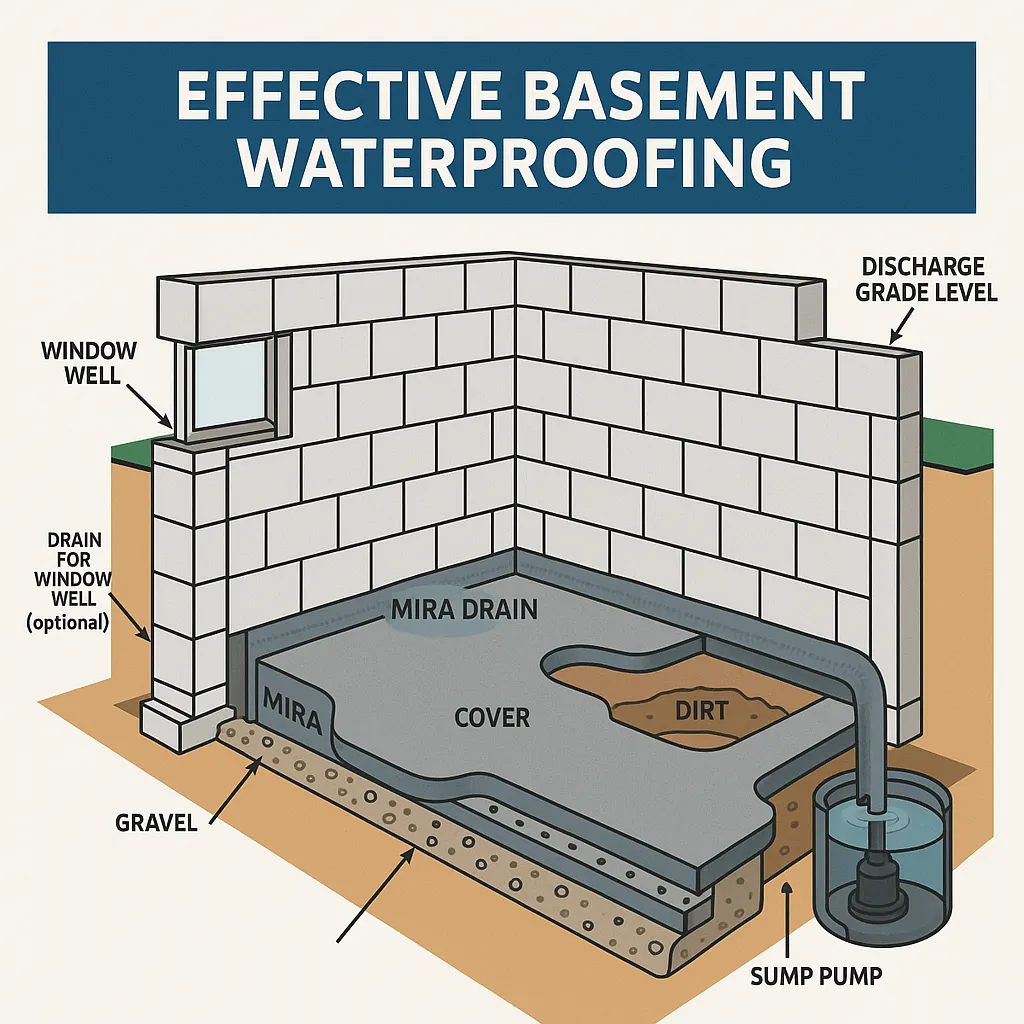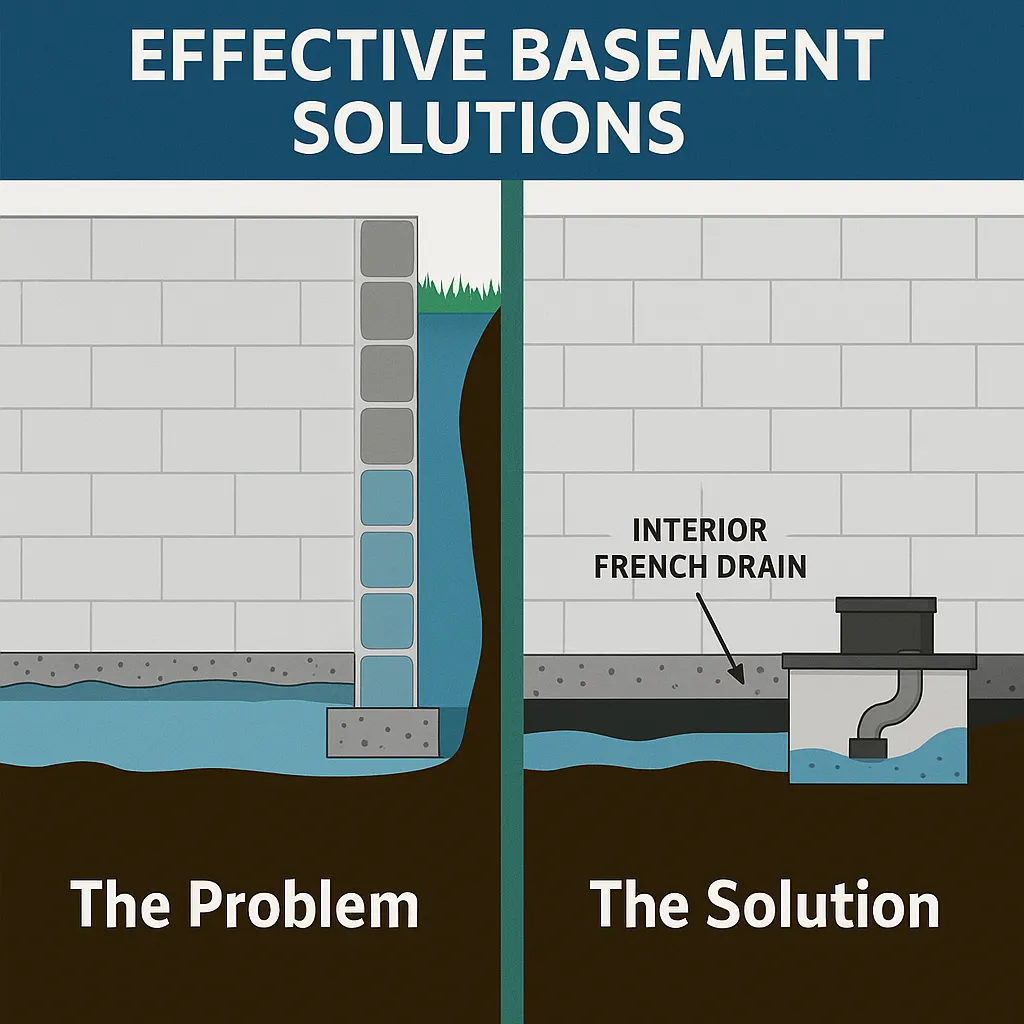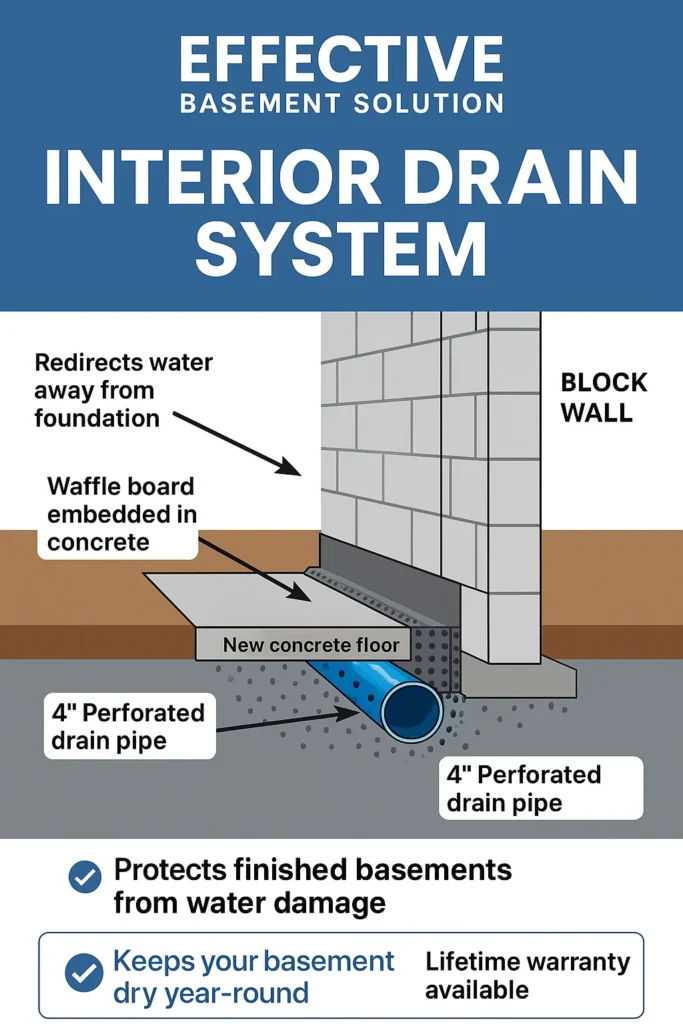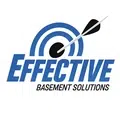
interior French drain contractor NJ — Expert Basement Drainage Solutions & Cost Guide
Basement water problems in New Jersey need focused, practical fixes. Interior French drains are one of the most reliable ways to stop seepage and relieve hydrostatic pressure. This guide walks through what an interior French drain is, how it performs in NJ basements, typical installation steps, the cost drivers you’ll see on estimates, and how to pick a licensed contractor for dependable long-term results. Homeowners will get clear explanations of system parts, realistic timeline expectations, and the decision points that tie soil type, local rainfall, and finished-basement concerns to the right drainage approach. We also compare interior and exterior drains, break down common cost items, and offer checklists to evaluate contractors and prepare your home. We use search-focused phrases—interior French drain contractor NJ, interior French drain installation NJ, basement waterproofing NJ—so this guide remains useful and locally relevant.
What Is an Interior French Drain and How Does It Work in NJ Basements?
interior French drain contractor NJ An interior French drain is a below-grade perimeter drainage system installed at the base of the basement wall or beneath the slab. It captures groundwater and directs it to a sump basin, where a pump removes it from the property, lowering hydrostatic pressure on the foundation. The system catches seeping water with a perforated pipe set in washed aggregate, wrapped in filter fabric, and sloped toward a sump pump. In New Jersey’s varied soils and frequent heavy rains, interior drains control groundwater that enters through cracks or porous masonry and stop it from migrating across floors and walls. The design addresses the usual failure points of below-grade walls and slabs, protecting finishes and structure by channeling water away before mold or progressive damage starts. Knowing how the system works helps homeowners evaluate materials, expected lifespan, and how the drain pairs with sump pumps and dehumidifiers.
What Are the Key Components of an Interior French Drain System?

An interior French drain depends on a handful of durable components that work together to collect and move groundwater out of the home. The perforated pipe is the central channel (typically PVC or corrugated HDPE) and sits in a bed of washed gravel or aggregate that provides flow space. Filter fabric keeps fine soil out of the gravel and pipe, reducing clogging and extending service life. A sump basin and pump collect the water and move it away from the foundation; many installations include battery backup or dual pumps for protection during power outages. These parts—pipe, aggregate, fabric, basin, and pump—make up the system, and choosing quality materials matched to local soil and water conditions improves long-term performance.
How Does an Interior French Drain Manage Basement Water and Hydrostatic Pressure?
Interior French drains relieve hydrostatic pressure by giving groundwater an easier, controlled path to follow—into a collection point and away from the foundation—instead of through cracks or porous masonry. When groundwater builds up around a foundation it exerts lateral force and finds the path of least resistance. By intercepting that water at the footing or slab perimeter, the drain lowers the local water table and eases stress on walls and joints. That translates to fewer leaks, reduced mold risk, and less cyclical wet/dry movement that can widen cracks. For homeowners, the result is a more stable basement and fewer emergency repairs. The next section explains why New Jersey conditions often make interior drains the practical choice.
The Pervasive Issue of Basement Water Infiltration: Etiology, Remediation, and Ramifications
Listings for “Waterproofing Contractors” across local directories reflect how common basement water infiltration is nationwide. This review looks at root causes, financial impacts, and mitigation tactics using case histories. It finds basement failures are usually the product of several interacting issues—one frequent factor is failing or poorly directed downspout drainage. When surface systems don’t move water away, hydrostatic pressure increases and can push water through foundation elements. Recommended responses include both routine maintenance and targeted structural reinforcement. Increasing homeowner awareness—through inspections and disclosure at sale—helps reduce risk and liability.
The Leaking Basement Epidemic–Causes, Cures and Consequences
If you want an on-site assessment, Effective Basement Solutions offers a free inspection to determine whether an interior French drain fits your basement’s soil, slab, and moisture patterns. A free inspection delivers an evidence-based scope of work and helps prioritize drainage and mold-prevention steps without a hard sell. Scheduling an inspection gives a clear path from diagnosis to a recommended system tailored to your home’s layout and local groundwater behavior, so you can decide between interior and exterior options with confidence.
Why Do NJ Homeowners Need Interior French Drains for Basement Waterproofing?
Interior French drains tackle the common sources of water intrusion New Jersey homeowners face by intercepting subsurface water before it reaches living spaces and finishes. Heavy seasonal rain, poor yard grading, and compacted or clay soils all raise lateral groundwater pressure against footings; interior drains provide a controlled route to a sump system that reduces that pressure. The system lowers basement humidity and visible dampness, cutting conditions that fuel mold and harm indoor air quality. In finished basements or locations where exterior access is limited, interior drains are often a less disruptive, cost-effective alternative to full exterior excavation while still addressing the hydrostatic drivers of leaks. The next section explains how that moisture control prevents mold and protects the structure.
How Do Interior French Drains Prevent Mold, Dampness, and Foundation Damage?
By collecting groundwater and sending it to a sump basin, interior French drains break the moisture paths that support mold and fungal growth, lowering relative humidity and stopping episodic wetting of finishes. Mold needs moisture plus organic material to thrive; keeping walls and floors drier reduces the chance of visible colonies and hidden growth behind finishes. Lowering hydrostatic pressure also reduces cyclic stress on foundation walls, slowing crack progression and differential movement that can require structural repairs. Early drainage work improves habitability now and reduces cumulative damage to finishes and framing over time.
What Are the Additional Benefits for Air Quality and Property Value?
Cutting basement moisture with an interior French drain improves indoor air quality by reducing musty odors, airborne spores, and humidity-related corrosion of mechanical equipment. Drier basements are easier and cheaper to condition, lowering strain on HVAC systems and dehumidifiers while creating healthier, more usable space for storage or living. From a resale standpoint, documented waterproofing and drainage measures reassure buyers because they address the root cause of water issues rather than masking symptoms. Those improvements help property presentation and can reduce negotiation friction during a sale—making drainage upgrades a preventive investment in health and marketability.
How Does the Interior French Drain Installation Process Work in New Jersey?

Installation follows a clear sequence that starts with a diagnostic inspection and ends with system testing and homeowner orientation. Licensed contractors begin with a moisture and foundation assessment to find infiltration points and decide whether perimeter trenching, sub-slab routing, or a combination is needed. The crew then removes the required floor material and cuts a trench along the perimeter to reach the footing or slab edge, installs perforated pipe in aggregate with filter fabric, ties the pipe into a sump basin, and restores the concrete or finish floor. Final steps include pump setup, testing, and cleanup. Modern in-house crews emphasize dust control and debris removal to minimize disruption. The table below outlines typical stages, durations, and what homeowners should expect so you can plan around the work.
| Installation Stage | Typical Duration | Homeowner Expectations |
|---|---|---|
| Inspection & Scope | 2–4 hours | Contractor documents moisture sources, recommends options; homeowner joins a walkthrough. |
| Trenching & Pipe Installation | 1–3 days | Concrete cutting with controlled dust and a temporary work zone; expect noise and limited basement access. |
| Sump Basin & Pump Setup | 0.5–1 day | Electrical hookup and pump testing; confirm discharge plan and backup options with the crew. |
| Backfill, Concrete Repair & Finish | 1–2 days | Concrete replacement and curing; plan for limited use of the repaired area for 24–48 hours. |
| Final Testing & Handoff | 1 day | System tested under flow; contractor reviews maintenance and warranty details with you. |
This timeline explains how each phase proceeds and what disruptions to expect, helping homeowners arrange storage or schedule adjustments while work is underway. Knowing the stage-by-stage flow also makes it easier to compare quotes and timelines between providers. The next section details the step-by-step actions a licensed contractor typically follows.
What Are the Step-by-Step Stages of Installation by a Licensed NJ Contractor?
A licensed contractor follows a consistent sequence to deliver a reliable, code-compliant drain. First, they perform a free inspection and moisture mapping to set the drain path and sump location. Next, the crew carefully cuts and removes concrete along the interior perimeter, lays filter fabric and aggregate, and places the perforated pipe sloped to the sump basin. Then they install the pump, complete electrical connections, backfill with aggregate, and restore the slab or floor finish. The job concludes with system testing and an owner orientation. Each stage focuses on containment, cleanup, and verification so the installation stays predictable and surprises are minimized.
How Long Does Installation Take and What Should Homeowners Expect?
Most standard basements take three to seven calendar days to complete, depending on access, the extent of concrete work, and any electrical or plumbing needs. Longer timelines come from larger basements, thick reinforced slabs, sub-slab obstructions, permit wait times, or unexpected foundation repairs discovered during work. Expect noise, dust-control measures, restricted basement use during active days, and a short curing period after concrete replacement before normal use resumes. Clear milestone communication and contingency allowances from your contractor help reduce stress during the project.
When comparing contractors, note that a licensed in-house crew can cut coordination delays and ensure consistent workmanship; Effective Basement Solutions uses licensed, in-house teams (no subcontractors) to streamline schedules and accountability. A licensed contractor provides a documented scope, trained crews, code compliance, and a clear testing and handoff process—ask for these commitments during your free inspection so expectations are set up front. Learn more about protecting your home with effective waterproofing solutions.
What Factors Influence Interior French Drain Cost in NJ?
Interior French drain costs vary by basement size, system complexity, pump and basin choices, and how much concrete repair is required. Major cost drivers include labor for cutting and restoring concrete, aggregate and pipe materials, sump basin and pump model, disposal of removed material, and any necessary permits or electrical work. Accessibility, soil type (clay or high water table), and discovered structural repairs also affect price because they add time and materials. The transparent cost table below shows common components and typical ranges so homeowners can compare estimates and prioritize options during an on-site assessment.
| Component | Typical Cost Range | Notes |
|---|---|---|
| Perimeter trenching & pipe | $800 – $2,500 | Depends on basement linear footage and depth required. |
| Aggregate & filter fabric | $200 – $800 | Material choice affects longevity and filtration performance. |
| Sump basin & standard pump | $400 – $1,200 | Higher-performance pumps or backups increase cost. |
| Concrete cutting & repair | $600 – $2,000 | Price varies with slab thickness and finish restoration needs. |
| Disposal, permits, electrical | $200 – $800 | Local permit fees and disposal hauling add to total estimate. |
What Are the Typical Price Ranges and Cost Components?
Jobs range from focused perimeter installs in small basements to full sub-slab systems in large or finished basements; the components above combine differently depending on complexity. Low-complexity projects center on a narrow trench and a standard pump, while high-complexity jobs add backup pumps, larger basins, and extensive concrete repair. Labor is usually the largest line item because of concrete work and careful installations near footings. Always compare written estimates that break down each line item so you confirm all proposals cover the same scope and avoid surprises at invoicing.
Are Financing Options or Free Estimates Available for NJ Homeowners?
Many contractors offer free inspections and written estimates so homeowners can review scope and price before deciding; Effective Basement Solutions explicitly provides a free inspection to determine whether an interior French drain is appropriate. Financing and payment plans vary by company, so ask contractors about available options, typical down payments, and payment schedules during the estimate. If cost is a concern, prioritize essential drainage components first—reliable sump pump and properly sloped pipe—then consider phased upgrades to balance budget and immediate protection needs.
How Do Interior French Drains Compare to Exterior French Drains for NJ Basements?
Both interior and exterior French drains manage groundwater, but they differ in installation method, disruption, cost, and which water sources they address best. Exterior systems require excavation around the foundation to place drainage at the footing level and handle surface and subsurface runoff before it reaches the foundation. Interior systems intercept water that has already migrated through the exterior barrier or soil. Exterior drains can offer broader yard-level control and are ideal for new construction or severe exterior drainage failures, but they’re more disruptive and costlier. Interior drains are less invasive to landscaping, faster to install, and often the practical choice for finished basements or tight properties where exterior access is limited. The table below summarizes pros and cons for easy comparison.
| System Type | Pros | Cons |
|---|---|---|
| Interior French Drain | Less landscaping disruption; faster install; effectively relieves hydrostatic pressure | Does not directly address surface runoff or high external water without grading fixes |
| Exterior French Drain | Handles surface and subsurface water before it reaches the foundation; comprehensive protection | Higher cost, major yard disruption, longer timeline |
| Combined/Hybrid Approach | Layered protection when exterior grading and interior drainage are both needed | Highest cost and requires coordination across trades |
What Are the Pros and Cons of Interior vs. Exterior French Drain Systems?
Interior systems are a good choice when you want to protect landscaping and minimize exterior disturbance; they quickly reduce basement humidity and visible leaks. Exterior drains are better when yard runoff or failed exterior waterproofing is the main problem. Interior systems can be paired with exterior grading or gutter improvements for a complete solution. Maintenance differs: interior systems depend on sump pump upkeep and occasional debris checks, while exterior systems require yard drainage maintenance and access to buried components when needed.
When Should NJ Homeowners Choose Interior French Drains Over Exterior Solutions?
Choose an interior drain when the basement is finished, exterior access is limited by neighboring properties or structures, or you need rapid remediation to make the space usable. Interior solutions are appropriate when hydrostatic pressure is the primary leak driver and when exterior excavation would be too disruptive or expensive. Exterior systems are recommended when surface drainage or major landscaping corrections are clearly the root cause. Assessing soil type, slope, and the condition of existing exterior waterproofing will show whether an interior-only approach is sufficient or if a combined strategy is the safer choice.
How to Choose the Right Interior French Drain Contractor in NJ?
Picking the right contractor means checking licensing, workmanship practices, warranties, and whether the crew on-site is in-house or subcontracted. Request clear, written scopes that list materials, pump specs, concrete restoration, and cleanup responsibilities. Look for reviews and references that show consistent completion of similar jobs and responsiveness to follow-up issues. Ask about testing procedures, maintenance training, and detailed warranty terms so you understand ongoing responsibilities and protections. The checklist below helps homeowners evaluate proposals and spot common red flags.
Choosing a contractor checklist:
- Verify Licensing and Insurance: Confirm the provider holds the required licenses and carries liability and worker coverage.
- Confirm In-House Crew vs Subcontractors: Favor companies that use in-house crews for consistent quality and accountability.
- Request Written Scope and Warranty: Get a detailed estimate with materials, timelines, and warranty terms in writing.
What Makes Effective Basement Solutions a Trusted NJ Interior French Drain Expert?
Effective Basement Solutions focuses on basement waterproofing across New Jersey with French drain installation as a core service. We use licensed, in-house installation crews (no subcontractors), take an education-first approach during inspections, and offer a free inspection to evaluate each home’s specific needs without pressure. As an information-first company, we prioritize clear, professional waterproofing solutions tailored to local soil and weather. Requesting our free inspection gives you an evidence-based scope and a transparent starting point to compare options and timelines.
What Should Homeowners Look for in Contractor Reviews, Warranties, and Service Guarantees?
When checking contractors, ask for recent local references and read warranty language carefully to confirm what’s covered, for how long, and who performs warranty work. Make sure the company explains post-installation service and pump maintenance. Avoid providers who won’t put scope in writing, dodge timelines, or rely heavily on subcontractors without clear accountability. Warning signs include high-pressure sales, vague cost estimates, and reluctance to show completed projects. Choose contractors that provide clear documentation, in-house crews, and an inspection-first approach to get a reliable, testable system.
- Ask for References: Request recent jobs similar in size and scope to your basement.
- Get Warranty in Writing: Confirm what is covered, for how long, and who performs warranty work.
- Verify Post-Install Support: Ensure the contractor explains maintenance tasks and will respond to follow-up questions.
Following these verification steps lowers the chance of unexpected costs and helps ensure the installed system performs as intended. These steps lead naturally into practical homeowner prep and maintenance guidance that protects your investment.
Conclusion
For New Jersey homeowners dealing with basement water issues, an interior French drain is a proven way to reduce hydrostatic pressure and prevent mold. Beyond improving indoor air quality, a properly installed system protects property value by addressing the underlying causes of water intrusion. Choosing a licensed contractor ensures a durable, tested solution that fits your home. Schedule your free inspection today to start the process toward a drier, healthier basement.
